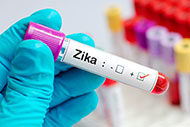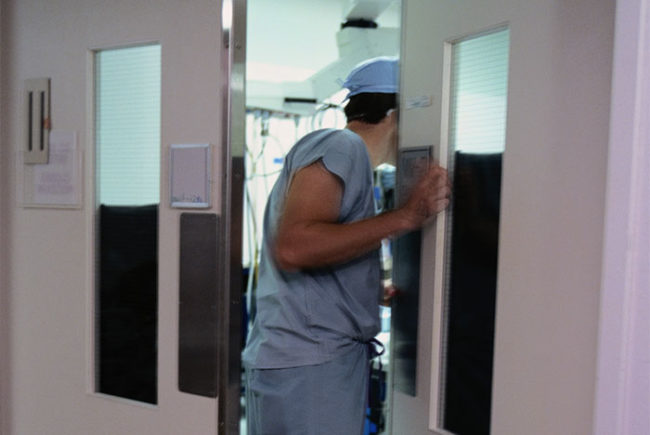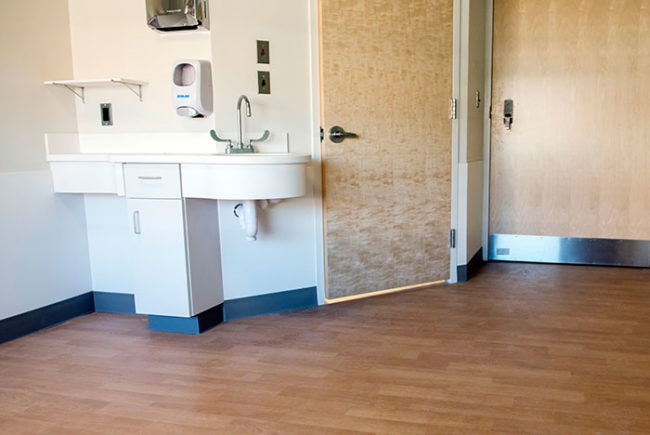Johns Hopkins gives peek at new Ebola protective suit
Engineering students at Johns Hopkins University have unveiled a prototype Ebola protective suit design that can be used to protect against various infectious diseases. The new design includes a coverall, hood and full body suit. Johns Hopkins says each product reduces the number of pieces required by current protocols, takes much less time to put on and remove, and cuts the number of potential contamination exposure points by nearly a third.
The suit includes a cooling system that helps to control humidity and overheating.
"The aim of our device is to extend the working time of health care workers in an Ebola Treatment Unit by increasing thermal comfort, and thus decrease the risk of heat-induced psychological and physiological impairments," the students who worked on the cooling system wrote in their final report.
Johns Hopkins formed an agreement with DuPont who is licensed to manufacturer the suit, which may be available yet this year.
Hand hygiene, PPE are effective practices against MERS
A descriptive study among 38 health care workers who treated a patient who contracted Middle East Respiratory Syndrome Coronavirus (MERS–CoV) was conducted to show if infection control best practices prove effective against MERS-CoV transmission. The study, conducted in Thailand, shows that 100 percent hand-hygiene compliance, using N95 respirators, performing respirator fit tests, and donning gowns, gloves, eye protection and caps can protect against MERS-CoV transmission in health care facilities.
ASPR highlights active-shooter safety in health care settings
The Department of Health & Human Services Assistant Secretary for Preparedness and Response (ASPR) called attention to the need for health care facilities to review safety plans in response to active-shooter events that are particular to each department.
Laura Kwinn Wolf, chief of the Critical Infrastructure Protection Branch, writes, “What would that response look like in your hospital? Your neonatal ICU? Your emergency department? Your infectious disease quarantine areas? How can you plan for a response that takes into account the special challenges throughout your hospital? And how can you make sure your staff knows what to do and is ready to act when seconds count?”
She lists several resources and planning guides to help health care facilities develop safety policies, and also calls on them to share effective strategies they have used in the field.
CDC releases interim draft Zika response plan
The Centers for Disease Control and Prevention (CDC) released its response plan for the first locally acquired cases of Zika virus infection in the continental United States and Hawaii. Most of the plan focuses on response activities that would occur after locally acquired Zika virus transmission has been identified. The CDC says the response activities outlined in the plan are based on currently available knowledge about Zika virus and its transmission, and that these activities may change as more is learned about it.
The plan calls for engaging a wide variety of stakeholders (e.g., health care providers, vector control organizations, medical associations, school associations, private enterprise) to assist with community preparedness and education.
Mobile phones used by staff can harbor pathogenic viruses
Samples taken from 109 professional and personal mobile phones of health care workers showed virus RNA on 38.5 percent of the phones. The presence of virus RNA was significantly associated with phones from the pediatric health care workers. Because mobile phones are routinely used in hospitals, even during care, and can host virus RNA, researchers of the study encourage frequent hand hygiene before and after mobile phone use, along with frequent cleaning of the devices.
IAHSS launches two new certification examinations and the latest Basic Training Manual
The International Association for Healthcare Security & Safety (IAHSS) recently launched a newly updated 2016 Certified Healthcare Protection Administrator (CHPA) certification examination, a new Basic certification examination, and the release of the 6th edition of the Basic Training Manual for Healthcare Security Officers.
The news initially was reported at the general meeting of the IAHSS membership at its May 22–25 Annual Conference & Exhibition in Charlotte, N.C.
Contaminated gloves touching hospital surfaces increases risk of cross-transmission of pathogens
Researchers at Nippon Medical School in Japan say there is clear evidence that the gloves of health care workers can contaminate hospital surfaces with bacteria.
Nitrile examination gloves were inoculated with specific microorganisms. The contaminated gloves were touched to a sterilized polypropylene surface. Then, the number of viable bacteria on the polypropylene surface was quantified. Acinetobacter baumannii remained on the polypropylene surface. In contrast, Escherichia coli, Klebsiella pneumoniae and Pseudomonas aeruginosa were not detected on the polypropylene surface. Antibiotic sensitivity of bacteria had no consistent effect on survival on the polypropylene surface.
“Infection control is a priority for all hospitals to reduce the spread of HCAIs [health care-associated infections],” said study author Sae Otani, a master course student at Bunkyo Gakuin University, “Gloving is recommended as a barrier protection for health care workers to reduce the risk of contamination during contact with infectious sputum, urine and body fluids,” she said. However, failure to change or remove contaminated gloves carries a high-risk of health care-associated pathogen transmission.





